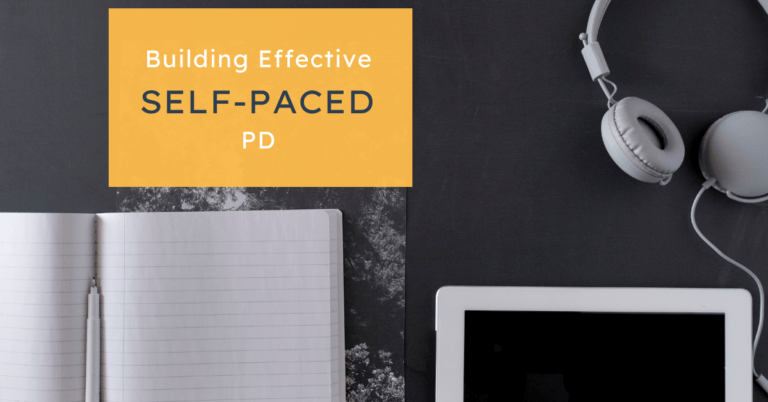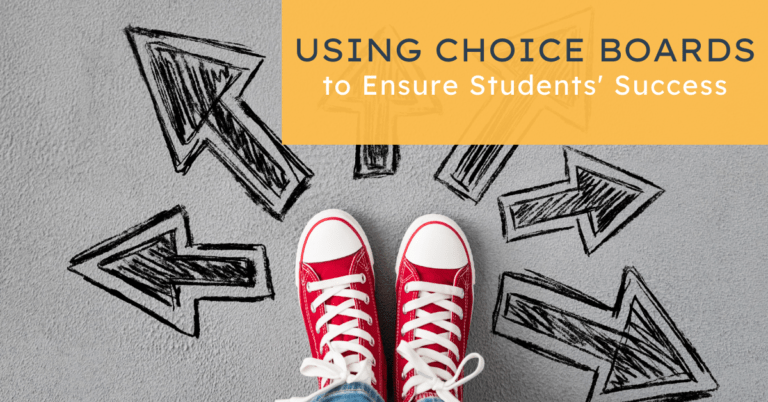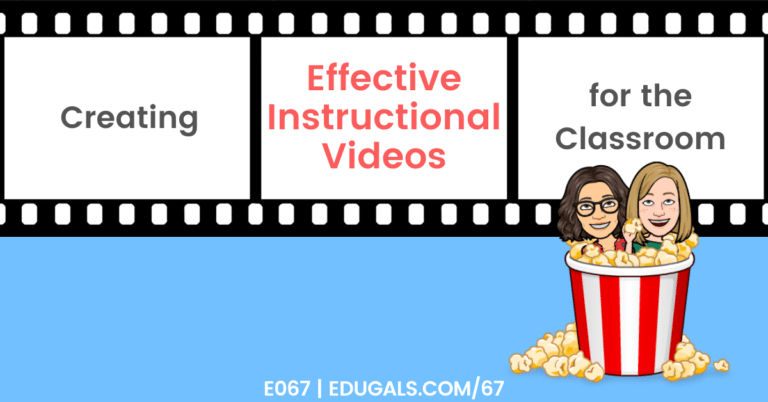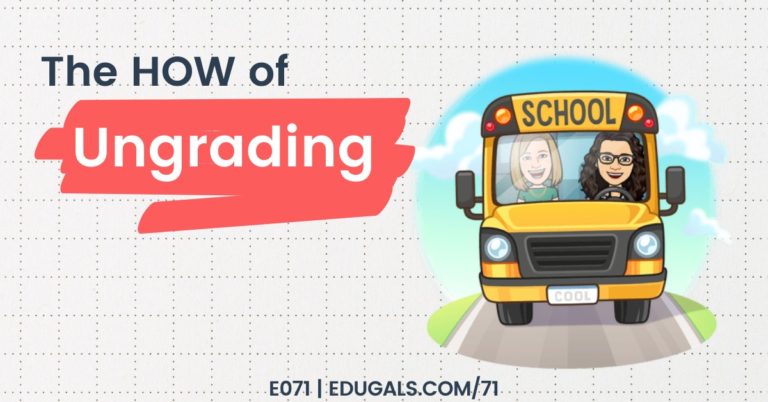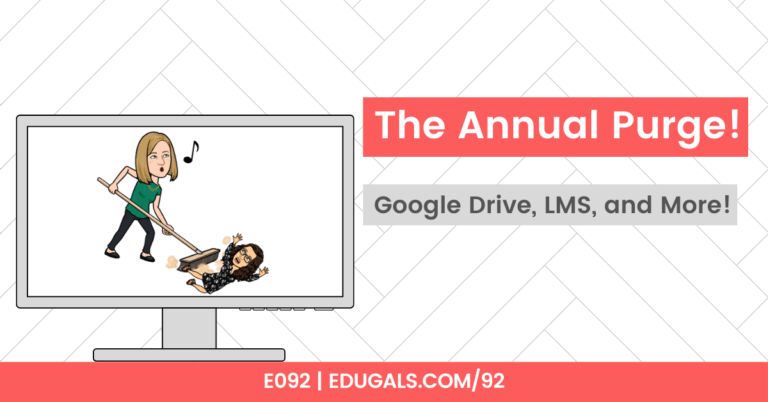In this episode, we are returning to the Universal Design for Learning (UDL), and looking at the representation pillar. Specifically, we will look at the second guideline, which focuses on language and symbols, and how we can support all learners in our classrooms.
If you like what you hear, we would love it if you could share this episode with a colleague or friend. And make sure you subscribe so that you don’t miss out on any new content! And consider supporting the show by buying us a coffee or two!
We would love to hear from you – leave a comment on our website OR check out our FLIP!
Show Notes
This week, we are bringing you back to the world of UDL, and talking about the second guideline in the Representation pillar: language and symbols. This one goes into linguistic and non-linguistic language and symbols, and looking at how we can ensure students are understanding what they are seeing and reading in class.
This particular section of UDL was quite exciting for Katie, as this is essentially what she works with on a daily basis – it’s all about the language we use, and ensuring accessibility for all – which she finds fascinating.
Rachel also finds this fascinating, in particular the idea of symbols, due to her experience learning and teaching math and science.
Together, this is a great episode for the pair!
When first looking at this area of UDL, it really came across as totally logical, and how we often overlook language symbols and assume they are easy and understood by all. Something as simple as an equal sign, however, may not be universally understood, so we need to make sure that all students are approaching it with the opportunity to make sense of what they are reading. We need to present things in a variety of forms, and have strategies on hand to ensure that students can make meaning of what they are looking at.
This is such an important conversation to have, as language and symbols really do vary subject by subject. An equal sign in math might be very different from an equal sign in a science course. There are so many nuances, so it makes a lot of sense that students might struggle.
In terms of this particular guidelines, there are 5 checkpoints, and we will go over each of them.
Checkpoint 1: Clarify vocabulary and symbols
This checkpoint concentrates specifically at words, symbols, numbers and icons. Students are dependent on their lived experiences, prior education, languages, cultures, etc. to access vocabulary and symbols. This means that they may not know the meaning in the specific context in which you are presenting it. With that in mind, supports are required in order to ensure that students can make sense of it all.
It’s also important to remember that there is a big difference between social language and academic language. As educators, we should define what both of those are for students, and how they interact or exist within out subject area.
Another thing that we often do without thinking twice is to use shorthand or short forms of words. It’s quite natural to assume that if I know that short form, then everyone must know that short form, but that is not necessarily the case!
If you catch yourself writing one on the board, or using one in a lesson, acknowledge it and explain it to students. Examples that we have had in our own practices are: NRG (energy) and gov’t (government).
Consider these terms as conversation starters about short forms of words, why and when they are used. It’s also a neat way to introduce additional short forms that are commonly used, and you could even crowdsource a glossary of sorts, where you can create a list of short forms and their explanations that are relevant to your course, or even as a more general list of terms that they can add to as they go.
Idioms are another big challenge because they are expressions that aren’t easily understood. They are phrases or expressions that have a different meaning than their literal meaning.
Some common idioms are:
- break a leg
- call it a day
- break the ice
- bite the bullet
These phrases are not easily understood by all students, so we need to be aware of the language we use, and ensure that we explain these types of expressions to our students.
Another strategy suggested is to pre-teach vocabulary and symbols, with a focus on using ways that promote students making connections to their experiences and prior knowledge.
Taking the time to highlight key terms that students should know, and taking the time to define and translate (if needed) the words. For more challenging words, you can always try a frayer model, or something similar. Either way, taking the time to work with the vocabulary prior to the actual lesson is something to consider, and is definitely worth it.
This preteaching of vocabulary should also include symbols, and a consideration of symbols that you are going to be using. One example is the use of a double arrow in chemistry. It’s important to define and explain what it means, and why it needs to be used.
Math and chemistry tend to have a lot of formulae, so taking the time to explain what each of the symbols stands for, and not just assuming all students know, is an important step to building comprehension and accessibility into your course.
Another way to building in vocabulary and symbol support is the use of hyperlinks. If there is a prior lesson that might be helpful for understanding, or perhaps a site that may go over unfamiliar information or explain a concept, you can easily hyperlink these resources into a digital lesson or note so that students can navigate, as needed, to these resources. It allows them to seek out extra information or explanation without having to stop the class or feel like they are falling behind. It’s a simple solution with a high impact.
In Google Classroom there’s a new feature called Practice Sets where you can set up questions, and then if students aren’t getting them correct, there are little buttons that they can press to get more information or to get help on a topic. This could be one excellent solution within Google to support some of this vocabulary and symbol teaching.
Checkpoint 2: Clarify syntax and structure
This checkpoint deals with how we combine different symbols, words, etc. and how the combination can change the meaning entirely. This is an area that can be one of the most challenging for language learners, as it requires knowing multiple definitions for terms based on different contexts. This is an area that can quickly lead to misunderstanding and/or misinterpretation of lessons, texts, etc.
The suggestions highlight for this area is to really make sure your lessons and texts are explicit. Highlight the structural relationships, or make connections between concepts from what was previously taught to what is being learned now. You may also consider highlighting transition words, or creating concept maps – these will help to ensure that syntax and structure are clear, and that they don’t impact understanding.
Checkpoint 3: Support decoding of text, mathematical notation, and symbols
This checkpoint is quite closely tied with what we have spoken about in the previous two checkpoints. It goes that next step, in that it focuses on the actual decoding and comprehension of texts and language, and ensuring that educators check in for understanding.
Just because a student is able to read aloud and sound out words, that doesn’t mean that they can actually comprehend that words. Some students may also require text to speech so that they can hear the words read aloud, so that they can actually understand. There can be disconnect between written text and spoken text, so we need to know our learners, and recognize that some will require different supports to make sense of text; not everyone reads with fluency and comprehension.
It’s also a good opportunity to look closely at your course, and if reading isn’t a strand or skill that needs to be isolated and demonstrated, then perhaps we give an alternate method to access that information. Adding in audio, even if it means you’re recording your own voice, is a great way to build in that support and ensure that students can access the content, and that there aren’t barriers in place that prevent them from learning.
Checkpoint 4: Promote understanding across languages
This one is definitely a big area of interest and advocacy for Katie. This checkpoint encourages. educators to make things available in students’ languages, or even allowing students to use their languages in order to express their learning.
It seems so simple, but it can be one of the toughest things for educators to implement.
There is no expectation that educators are translators or linguists that can understand all languages, but there are ways for teachers to figure out the meaning and check for content understanding. For example, in Katie’s Grade 10 history class, there have been times where students are struggling to remember some English words, so she allowed them to write those terms in their first language. From the Google Translate app, I could easily take a picture of the text, and it automatically translated it to English.
One thing to note: apps like Google Translate are not going to be perfect! That being said, it easily identifies the subject and the ideas that the student has, even if it isn’t grammatically accurate. This helps break down language barriers, and it helps students feel successful, and like their languages are valued.
First languages are definitely a source that we need to be tapping into as educators. Students have background knowledge based on their prior education experiences, and utilizing their first languages is a great way to figure out what students know, and to build on the skills and knowledge that they have.
The use of multilingual glossaries is a great way to do exactly that. We’ve spoken about it before in a previous episode, however creating these as a class is such a powerful way to show value to all of the languages students bring with them while also making meaningful connections to new vocabulary words, phrases, etc.
If you don’t want to create one, there are lots of dual language and multilingual glossaries out there. Here are a couple of links to sites and glossaries that have been built by other educators and/or organizations:
- Kimiko Shabato (@ESLFairy – Twitter) – Dual language science vocab
- Bilingual Glossaries (from NYU Steinhardt)
They may not be perfect, and they may not identify all of the words and phrases that you use, but they are a really good start, and should be considered as a first step. As you build your own, consider using multiple modalities to represent these terms, such as images, videos, audio, text. etc.
Checkpoint 5: Illustrate through multiple media
In this checkpoint, it is explained that text isn’t always the best platform or modality for those with language-related disabilities or who struggle with reading and/or decoding. Text makes these challenges even more daunting for this group of students.
With that in mind, it’s important to consider alternatives, such as providing illustrations or images, graphics, videos, etc. to help bring text to life.
Simulations in science are a great way to show students what is happening and to help them visualize the processes of something that you may not always be able to see. Reading alone won’t cut it, and it won’t help students to see and understand these processes.
While short and sweet, this checkpoint acted as a good reminder to slow down, and to find multiple ways to present new information and knowledge to students.
All of these checkpoints are so closely related, but they do a great job of coming together to demonstrate the important of language and symbols in the classroom, and how we can support our students to make sense of them.
